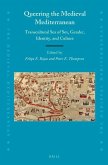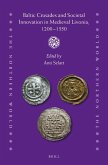Encounters: Medieval Islamic History in 50 Objects
Herausgeber: Milwright, Marcus
Encounters: Medieval Islamic History in 50 Objects
Herausgeber: Milwright, Marcus
- Gebundenes Buch
- Merkliste
- Auf die Merkliste
- Bewerten Bewerten
- Teilen
- Produkt teilen
- Produkterinnerung
- Produkterinnerung
This book comprises of fifty case studies and offers an innovative approach to the study of Medieval Islamic history, concentrating on the analysis of physical objects from the seventh to the eighteenth centuries and across most of the regions that make up the pre-Modern Islamic world.
Andere Kunden interessierten sich auch für
![Normal Women Normal Women]() Philippa GregoryNormal Women29,99 €
Philippa GregoryNormal Women29,99 €![Echoing Hooves: Studies on Horses and Their Effects on Medieval Societies Echoing Hooves: Studies on Horses and Their Effects on Medieval Societies]() Echoing Hooves: Studies on Horses and Their Effects on Medieval Societies178,99 €
Echoing Hooves: Studies on Horses and Their Effects on Medieval Societies178,99 €![Origin Legends in Early Medieval Western Europe Origin Legends in Early Medieval Western Europe]() Origin Legends in Early Medieval Western Europe209,99 €
Origin Legends in Early Medieval Western Europe209,99 €![Queering the Medieval Mediterranean: Transcultural Sea of Sex, Gender, Identity, and Culture Queering the Medieval Mediterranean: Transcultural Sea of Sex, Gender, Identity, and Culture]() Queering the Medieval Mediterranean: Transcultural Sea of Sex, Gender, Identity, and Culture111,99 €
Queering the Medieval Mediterranean: Transcultural Sea of Sex, Gender, Identity, and Culture111,99 €![Records and Processes of Dispute Settlement in Early Medieval Societies Records and Processes of Dispute Settlement in Early Medieval Societies]() Records and Processes of Dispute Settlement in Early Medieval Societies153,99 €
Records and Processes of Dispute Settlement in Early Medieval Societies153,99 €![Baltic Crusades and Societal Innovation in Medieval Livonia, 1200-1350 Baltic Crusades and Societal Innovation in Medieval Livonia, 1200-1350]() Baltic Crusades and Societal Innovation in Medieval Livonia, 1200-1350146,99 €
Baltic Crusades and Societal Innovation in Medieval Livonia, 1200-1350146,99 €![Early Medieval English Life Courses Early Medieval English Life Courses]() Early Medieval English Life Courses171,99 €
Early Medieval English Life Courses171,99 €-
-
-
This book comprises of fifty case studies and offers an innovative approach to the study of Medieval Islamic history, concentrating on the analysis of physical objects from the seventh to the eighteenth centuries and across most of the regions that make up the pre-Modern Islamic world.
Produktdetails
- Produktdetails
- Verlag: Taylor & Francis
- Seitenzahl: 354
- Erscheinungstermin: 27. Oktober 2025
- Englisch
- Abmessung: 240mm x 161mm x 26mm
- Gewicht: 763g
- ISBN-13: 9781032537047
- ISBN-10: 1032537043
- Artikelnr.: 74440655
- Herstellerkennzeichnung
- Libri GmbH
- Europaallee 1
- 36244 Bad Hersfeld
- gpsr@libri.de
- Verlag: Taylor & Francis
- Seitenzahl: 354
- Erscheinungstermin: 27. Oktober 2025
- Englisch
- Abmessung: 240mm x 161mm x 26mm
- Gewicht: 763g
- ISBN-13: 9781032537047
- ISBN-10: 1032537043
- Artikelnr.: 74440655
- Herstellerkennzeichnung
- Libri GmbH
- Europaallee 1
- 36244 Bad Hersfeld
- gpsr@libri.de
Marcus Milwright is a British Academy Global Professor in the Department of History of Art, University of York (UK) and Professor of Islamic art at the University of Victoria (Canada). His research interests include the arts and archaeology of the Islamic world, traditional crafts practices, cross-cultural interaction in the Medieval period, and the history of medicine. Publications include A Story of Islamic Art (2023), The Queen of Sheba's Gift: A History of the True Balsam of Matarea (2022) and The Dome of the Rock and its Umayyad Mosaic Inscriptions (2016).
Section 1: The Formative Phase, c. 650-800 Chapter 1: A Bifolium from a Hijazi Qur
an Chapter 2: The Shahada Solidus Chapter 3: The
Umari Mosque in Busra Chapter 4: The Mosaic Floor of the Church of St Stephen, Umm al-Rasas Chapter 5: An Inscription from Qasr al-Hayr al-Gharbi Section 2: Expanded Horizons, c. 800-1000 Chapter 6: A Tin-Glazed Bowl painted with Cobalt Chapter 7: The Palace of Balkuwara, Samarra Chapter 8: A Folio from the Tashkent Qur
an Chapter 9: The Maqsura of the Congregational Mosque of Qayrawan Chapter 10: The Leyre Casket Section 3: Political and Cultural Diversity, c. 1000-1400 Chapter 11: Reused Marble Capitals on the Minaret in Seville Chapter 12: The Façade of al-Aqmar Mosque, Cairo Chapter 13: An Inlaid Brass Jug from Mosul Chapter 14: Wall Painting in the Abu Säid Mausoleum, near Mihna Chapter 15: The Qutb Mosque, Delhi Section 4: Realignments, c. 1400-1800 Chapter 16: Tombstones from Aceh, Sumatra Chapter 17: The Emin Minaret, Turfan Chapter 18: A Deccani Steel
Alam Chapter 19: An Ottoman Topographic View of
nebaht
(Nafpaktos), Greece Chapter 20: Clay Tobacco Pipes from a Workshop in Cairo Section 5: The Rural Environment Chapter 21: Caliph Mu
awiya's Dam near Täif Chapter 22: The Aflaj of Wadi al-Jizzi, Oman Chapter 23: Kuh-Qal
ih of Tun Chapter 24: A Handmade Ceramic Jug from southern Jordan Chapter 25: A Sugar Refinery at Chichaoua, Morocco Section 6: Manufacturing and the Economy Chapter 26: An early Islamic Glass Weight Chapter 27: A Decorated Albarello Chapter 28: An illustrated Page from the Mantiq al-Wahsh Chapter 29: Indian Block-Printed Cotton Textiles Chapter 30: A Carpet from Late Mamluk Egypt Section 7: The Movement of Goods and People Chapter 31: Samanid Dirhams buried at Storr Rock, Orkney Chapter 32: The Caravanserai of Ribat-i Mahi Chapter 33: An Iranian Gold Seal Ring Chapter 34: A Slave Market from the Maqamat of al-Hariri Chapter 35: The Hajj Fort at Qatrana Section 8: Faith in Practice Chapter 36: A Mosque in Shanga Chapter 37: A Rock-Cut Panel from the Viar (Dash Kassan) Complex Chapter 38: The Tomb of Mubarak Khan in the Makli Necropolis, Thatta Chapter 39: A Stucco Mihrab at Zuzan Chapter 40: A Talismanic shirt Section 9: The Scholarly Elite Chapter 41: The Mausoleum of Imam Shafi
i, Cairo Chapter 42: A Safavid Lacquer Pen Box Chapter 43: A Page from a Notebook written by al-Maqrizi Chapter 44: A Fourteenth-century Drawing of a Water Clock Chapter 45: A Battle Scene from Rashid al-Din's Jami
al-Tawarikh Section 10: Alternative Perspectives and Marginalised Voices Chapter 46: A Paper Amulet from Egypt Chapter 47: The Hospital of Arghun al-Kamili, Aleppo Chapter 48: A Mughal Portrait of Inayat Khan Chapter 49: A Painting of Shah
Abbas and his Page Chapter 50: A Shadow Puppet from Ottoman Damascus
an Chapter 2: The Shahada Solidus Chapter 3: The
Umari Mosque in Busra Chapter 4: The Mosaic Floor of the Church of St Stephen, Umm al-Rasas Chapter 5: An Inscription from Qasr al-Hayr al-Gharbi Section 2: Expanded Horizons, c. 800-1000 Chapter 6: A Tin-Glazed Bowl painted with Cobalt Chapter 7: The Palace of Balkuwara, Samarra Chapter 8: A Folio from the Tashkent Qur
an Chapter 9: The Maqsura of the Congregational Mosque of Qayrawan Chapter 10: The Leyre Casket Section 3: Political and Cultural Diversity, c. 1000-1400 Chapter 11: Reused Marble Capitals on the Minaret in Seville Chapter 12: The Façade of al-Aqmar Mosque, Cairo Chapter 13: An Inlaid Brass Jug from Mosul Chapter 14: Wall Painting in the Abu Säid Mausoleum, near Mihna Chapter 15: The Qutb Mosque, Delhi Section 4: Realignments, c. 1400-1800 Chapter 16: Tombstones from Aceh, Sumatra Chapter 17: The Emin Minaret, Turfan Chapter 18: A Deccani Steel
Alam Chapter 19: An Ottoman Topographic View of
nebaht
(Nafpaktos), Greece Chapter 20: Clay Tobacco Pipes from a Workshop in Cairo Section 5: The Rural Environment Chapter 21: Caliph Mu
awiya's Dam near Täif Chapter 22: The Aflaj of Wadi al-Jizzi, Oman Chapter 23: Kuh-Qal
ih of Tun Chapter 24: A Handmade Ceramic Jug from southern Jordan Chapter 25: A Sugar Refinery at Chichaoua, Morocco Section 6: Manufacturing and the Economy Chapter 26: An early Islamic Glass Weight Chapter 27: A Decorated Albarello Chapter 28: An illustrated Page from the Mantiq al-Wahsh Chapter 29: Indian Block-Printed Cotton Textiles Chapter 30: A Carpet from Late Mamluk Egypt Section 7: The Movement of Goods and People Chapter 31: Samanid Dirhams buried at Storr Rock, Orkney Chapter 32: The Caravanserai of Ribat-i Mahi Chapter 33: An Iranian Gold Seal Ring Chapter 34: A Slave Market from the Maqamat of al-Hariri Chapter 35: The Hajj Fort at Qatrana Section 8: Faith in Practice Chapter 36: A Mosque in Shanga Chapter 37: A Rock-Cut Panel from the Viar (Dash Kassan) Complex Chapter 38: The Tomb of Mubarak Khan in the Makli Necropolis, Thatta Chapter 39: A Stucco Mihrab at Zuzan Chapter 40: A Talismanic shirt Section 9: The Scholarly Elite Chapter 41: The Mausoleum of Imam Shafi
i, Cairo Chapter 42: A Safavid Lacquer Pen Box Chapter 43: A Page from a Notebook written by al-Maqrizi Chapter 44: A Fourteenth-century Drawing of a Water Clock Chapter 45: A Battle Scene from Rashid al-Din's Jami
al-Tawarikh Section 10: Alternative Perspectives and Marginalised Voices Chapter 46: A Paper Amulet from Egypt Chapter 47: The Hospital of Arghun al-Kamili, Aleppo Chapter 48: A Mughal Portrait of Inayat Khan Chapter 49: A Painting of Shah
Abbas and his Page Chapter 50: A Shadow Puppet from Ottoman Damascus
Section 1: The Formative Phase, c. 650-800 Chapter 1: A Bifolium from a Hijazi Qur
an Chapter 2: The Shahada Solidus Chapter 3: The
Umari Mosque in Busra Chapter 4: The Mosaic Floor of the Church of St Stephen, Umm al-Rasas Chapter 5: An Inscription from Qasr al-Hayr al-Gharbi Section 2: Expanded Horizons, c. 800-1000 Chapter 6: A Tin-Glazed Bowl painted with Cobalt Chapter 7: The Palace of Balkuwara, Samarra Chapter 8: A Folio from the Tashkent Qur
an Chapter 9: The Maqsura of the Congregational Mosque of Qayrawan Chapter 10: The Leyre Casket Section 3: Political and Cultural Diversity, c. 1000-1400 Chapter 11: Reused Marble Capitals on the Minaret in Seville Chapter 12: The Façade of al-Aqmar Mosque, Cairo Chapter 13: An Inlaid Brass Jug from Mosul Chapter 14: Wall Painting in the Abu Säid Mausoleum, near Mihna Chapter 15: The Qutb Mosque, Delhi Section 4: Realignments, c. 1400-1800 Chapter 16: Tombstones from Aceh, Sumatra Chapter 17: The Emin Minaret, Turfan Chapter 18: A Deccani Steel
Alam Chapter 19: An Ottoman Topographic View of
nebaht
(Nafpaktos), Greece Chapter 20: Clay Tobacco Pipes from a Workshop in Cairo Section 5: The Rural Environment Chapter 21: Caliph Mu
awiya's Dam near Täif Chapter 22: The Aflaj of Wadi al-Jizzi, Oman Chapter 23: Kuh-Qal
ih of Tun Chapter 24: A Handmade Ceramic Jug from southern Jordan Chapter 25: A Sugar Refinery at Chichaoua, Morocco Section 6: Manufacturing and the Economy Chapter 26: An early Islamic Glass Weight Chapter 27: A Decorated Albarello Chapter 28: An illustrated Page from the Mantiq al-Wahsh Chapter 29: Indian Block-Printed Cotton Textiles Chapter 30: A Carpet from Late Mamluk Egypt Section 7: The Movement of Goods and People Chapter 31: Samanid Dirhams buried at Storr Rock, Orkney Chapter 32: The Caravanserai of Ribat-i Mahi Chapter 33: An Iranian Gold Seal Ring Chapter 34: A Slave Market from the Maqamat of al-Hariri Chapter 35: The Hajj Fort at Qatrana Section 8: Faith in Practice Chapter 36: A Mosque in Shanga Chapter 37: A Rock-Cut Panel from the Viar (Dash Kassan) Complex Chapter 38: The Tomb of Mubarak Khan in the Makli Necropolis, Thatta Chapter 39: A Stucco Mihrab at Zuzan Chapter 40: A Talismanic shirt Section 9: The Scholarly Elite Chapter 41: The Mausoleum of Imam Shafi
i, Cairo Chapter 42: A Safavid Lacquer Pen Box Chapter 43: A Page from a Notebook written by al-Maqrizi Chapter 44: A Fourteenth-century Drawing of a Water Clock Chapter 45: A Battle Scene from Rashid al-Din's Jami
al-Tawarikh Section 10: Alternative Perspectives and Marginalised Voices Chapter 46: A Paper Amulet from Egypt Chapter 47: The Hospital of Arghun al-Kamili, Aleppo Chapter 48: A Mughal Portrait of Inayat Khan Chapter 49: A Painting of Shah
Abbas and his Page Chapter 50: A Shadow Puppet from Ottoman Damascus
an Chapter 2: The Shahada Solidus Chapter 3: The
Umari Mosque in Busra Chapter 4: The Mosaic Floor of the Church of St Stephen, Umm al-Rasas Chapter 5: An Inscription from Qasr al-Hayr al-Gharbi Section 2: Expanded Horizons, c. 800-1000 Chapter 6: A Tin-Glazed Bowl painted with Cobalt Chapter 7: The Palace of Balkuwara, Samarra Chapter 8: A Folio from the Tashkent Qur
an Chapter 9: The Maqsura of the Congregational Mosque of Qayrawan Chapter 10: The Leyre Casket Section 3: Political and Cultural Diversity, c. 1000-1400 Chapter 11: Reused Marble Capitals on the Minaret in Seville Chapter 12: The Façade of al-Aqmar Mosque, Cairo Chapter 13: An Inlaid Brass Jug from Mosul Chapter 14: Wall Painting in the Abu Säid Mausoleum, near Mihna Chapter 15: The Qutb Mosque, Delhi Section 4: Realignments, c. 1400-1800 Chapter 16: Tombstones from Aceh, Sumatra Chapter 17: The Emin Minaret, Turfan Chapter 18: A Deccani Steel
Alam Chapter 19: An Ottoman Topographic View of
nebaht
(Nafpaktos), Greece Chapter 20: Clay Tobacco Pipes from a Workshop in Cairo Section 5: The Rural Environment Chapter 21: Caliph Mu
awiya's Dam near Täif Chapter 22: The Aflaj of Wadi al-Jizzi, Oman Chapter 23: Kuh-Qal
ih of Tun Chapter 24: A Handmade Ceramic Jug from southern Jordan Chapter 25: A Sugar Refinery at Chichaoua, Morocco Section 6: Manufacturing and the Economy Chapter 26: An early Islamic Glass Weight Chapter 27: A Decorated Albarello Chapter 28: An illustrated Page from the Mantiq al-Wahsh Chapter 29: Indian Block-Printed Cotton Textiles Chapter 30: A Carpet from Late Mamluk Egypt Section 7: The Movement of Goods and People Chapter 31: Samanid Dirhams buried at Storr Rock, Orkney Chapter 32: The Caravanserai of Ribat-i Mahi Chapter 33: An Iranian Gold Seal Ring Chapter 34: A Slave Market from the Maqamat of al-Hariri Chapter 35: The Hajj Fort at Qatrana Section 8: Faith in Practice Chapter 36: A Mosque in Shanga Chapter 37: A Rock-Cut Panel from the Viar (Dash Kassan) Complex Chapter 38: The Tomb of Mubarak Khan in the Makli Necropolis, Thatta Chapter 39: A Stucco Mihrab at Zuzan Chapter 40: A Talismanic shirt Section 9: The Scholarly Elite Chapter 41: The Mausoleum of Imam Shafi
i, Cairo Chapter 42: A Safavid Lacquer Pen Box Chapter 43: A Page from a Notebook written by al-Maqrizi Chapter 44: A Fourteenth-century Drawing of a Water Clock Chapter 45: A Battle Scene from Rashid al-Din's Jami
al-Tawarikh Section 10: Alternative Perspectives and Marginalised Voices Chapter 46: A Paper Amulet from Egypt Chapter 47: The Hospital of Arghun al-Kamili, Aleppo Chapter 48: A Mughal Portrait of Inayat Khan Chapter 49: A Painting of Shah
Abbas and his Page Chapter 50: A Shadow Puppet from Ottoman Damascus








